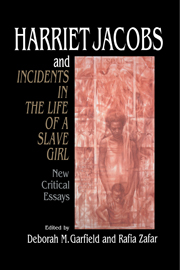Book contents
- Frontmatter
- Contents
- Introduction: Over-exposed, Under-exposed: Harriet Jacobs and Incidents in the Life of a Slave Girl
- “I Disguised My Hand”: Writing Versions of the Truth in Harriet Jacobs's Incidents in the life of a Slave Girl and John Jacobs's “A True Tale of Slavery”
- Through Her Brother's Eyes: Incidents and “A True Tale”
- Resisting Incidents
- Manifest in Signs: The Politics of Sex and Representation in Incidents in the life of a Slave Girl
- Earwitness: Female Abolitionism, Sexuality, and Incidents in the life of a Slave Girl
- Reading and Redemption in Incidents in the Life of a Slave Girl
- Harriet Jacobs, Frederick Douglass, and the Slavery Debate: Bondage, Family, and the Discourse of Domesticity
- Motherhood Beyond the Gate: Jacobs's Epistemic Challenge in Incidents in the Life of a Slave Girl
- “This Poisonous System”: Social Ills, Bodily Ills, and Incidents in the Life of a Slave Girl
- Carnival Laughter: Resistance in Incidents
- Harriet Jacobs, Henry Thoreau, and the Character of Disobedience
- The Tender of Memory: Restructuring Value in Harriet Jacobs's Incidents in the Life of a Slave Girl
- Conclusion: Vexed Alliances: Race and Female Collaborations in the Life of Harriet Jacobs
- List of Contributors
- Index
- CAMBRIDGE STUDIES IN AMERICAN LITERATURE AND CULTURE
Carnival Laughter: Resistance in Incidents
Published online by Cambridge University Press: 22 January 2010
- Frontmatter
- Contents
- Introduction: Over-exposed, Under-exposed: Harriet Jacobs and Incidents in the Life of a Slave Girl
- “I Disguised My Hand”: Writing Versions of the Truth in Harriet Jacobs's Incidents in the life of a Slave Girl and John Jacobs's “A True Tale of Slavery”
- Through Her Brother's Eyes: Incidents and “A True Tale”
- Resisting Incidents
- Manifest in Signs: The Politics of Sex and Representation in Incidents in the life of a Slave Girl
- Earwitness: Female Abolitionism, Sexuality, and Incidents in the life of a Slave Girl
- Reading and Redemption in Incidents in the Life of a Slave Girl
- Harriet Jacobs, Frederick Douglass, and the Slavery Debate: Bondage, Family, and the Discourse of Domesticity
- Motherhood Beyond the Gate: Jacobs's Epistemic Challenge in Incidents in the Life of a Slave Girl
- “This Poisonous System”: Social Ills, Bodily Ills, and Incidents in the Life of a Slave Girl
- Carnival Laughter: Resistance in Incidents
- Harriet Jacobs, Henry Thoreau, and the Character of Disobedience
- The Tender of Memory: Restructuring Value in Harriet Jacobs's Incidents in the Life of a Slave Girl
- Conclusion: Vexed Alliances: Race and Female Collaborations in the Life of Harriet Jacobs
- List of Contributors
- Index
- CAMBRIDGE STUDIES IN AMERICAN LITERATURE AND CULTURE
Summary
Every child rises early on Christmas morning to see the Johnkannaus. Without them, Christmas would be shorn of its greatest attraction.
Harriet A.Jacobs[The carnivals] were the second life of the people, who for a time entered the Utopian realm of community, freedom, equality, and abundance.
Mikhail BakhtinThe Negroes have no manner of religion by what I could observe of them. It is true that they have several ceremonies, as dances, playing etc., but these for the most part are so far from being acts of adoration of a God that they are for the most part mixed with a great deal of bawdy and lewdness.
Sir Hans SloaneThe Johnkannau festival of the New World seems as diverse in its origins as in its interpretations. In itself a heteroglossia of African languages and rituals re-created in the hostile environment of New World slavery, the Johnkannau has been perceived as children's amusement, godless bawdy, sacred ritual, and folk resistance. Occurring in a critical middle chapter in Incidents in the Life of a Slave Girl, Harriet Jacobs's description of the Johnkannau becomes a central trope for the multiple concerns of her slave narrative. She deliberately blends her narrating voice with this all-male raillery, suggesting Linda Brent's female appropriation of an African American trickster figure. And in this role Linda Brent enacts the ritual, undertaking – through dialogue and disguise in the narrative – diverse voices. The dance, music, and song of the festival, both in action and language, become a multidimensional medium of expression for the African American in slavery.
- Type
- Chapter
- Information
- Harriet Jacobs and Incidents in the Life of a Slave GirlNew Critical Essays, pp. 216 - 232Publisher: Cambridge University PressPrint publication year: 1996
- 3
- Cited by



